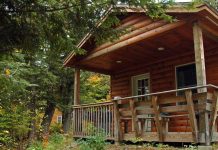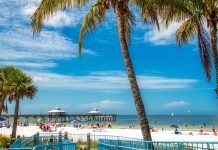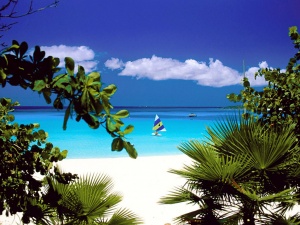May 19, 2015By: John Stone
 |
| Thuringia Garden Show in Schmalkalden // Photo by Maureen Stone |
Thuringia, a region branded as “the cultural heart of Germany” and located in the dead center of the country, has been primarily a domestic tourism destination attracting almost 95 percent German guests since the nation’s 1990 reunification. Starting with this year’s eventful German Travel Mart, hosted during April’s final days in the cities of Erfurt and Weimar, the German National Tourist Board and the Thuringia Tourist Board have served notice they are on a mission to attract the international market, including Americans, to their hidden gem.
The region’s modern tourism handicap is rooted in 1945’s World War II geopolitical outcome. The allied division of the eastern side of Germany put postwar Bavaria under American control and its northerly neighbor Thuringia in Russian territory. Thuringia and four other eastern states fell into the German Democratic Republic (GDR), under which Thuringian students were required to study Russian instead of the English taught and widely spoken in postwar western Germany.
“After 40 years behind the Iron Curtain it is not easy for a [region] to catch up. We are the Sleeping Beauty,” said Barbel Gronegres, the managing director of Thuringia Tourism to the assembled press corps at the 41st German Travel Mart in Thuringia’s capital city of Erfurt last month. In an engaging jab at neighboring Bavaria, and its wildly-popular Sleeping Beauty castle in Neuschwanstein, Gronegres noted that King Ludwig II was inspired to construct his 19th century palace after first visiting Thuringia’s 12th-century Wartburg castle in Eisenach. “People love Neuschwanstein, but that is not the original,” said the smiling Thuringia managing director. “Wartburg is the original.”
Thuringia is the home of Bach, Luther, the Protestant Reformation, the bratwurst sausage, and arguably the most authentic collection of medieval villages in Europe. Yet it is a region unknown to Americans despite its geographic position midway between the cities of Frankfurt and Berlin, and immediately north of Bavaria, the most popular tourism state in Germany. While it may sound unsurprising to learn that Thuringia received only 24,161 overnight stays by Americans in 2014 out of the record 5.2 million American overnights in all of Germany, the low numbers are stunning to anyone who has recently visited the region and seen its tourism gold mine. The numbers say that less than half of one percent of Americans who have visited Germany have seen Thuringia.
Today English is understood – although not fluently spoken – among Thuringian tourism hosts, including some hotel desks, primarily because the region has previously seen few English-speaking guests. But expert, fluent city guides, available through Thuringia’s state and city tourist offices, can be arranged in every town to make the visiting experience a series of stunningly enjoyable revelations for groups or individuals. These are Thuringian natives proud to reveal their hidden treasures.
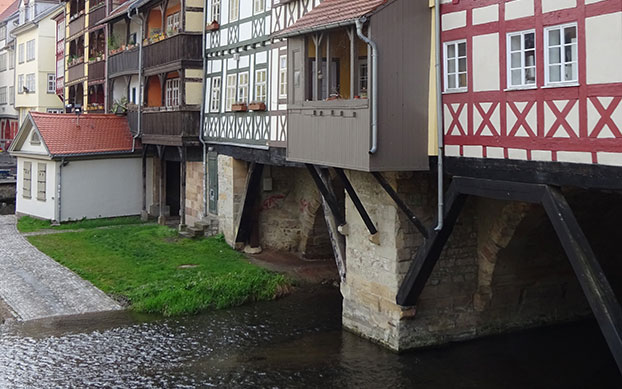 |
| Merchant Bridge in Erfurt // Photo by Maureen Stone |
What Americans Are Missing
Travel Agent visited 11 of Thuringia’s cities and towns during the week of May Day, a national holiday in Germany. Here is a brief sketch of some of the region’s highlights for travel planners to consider.
Erfurt
The Thuringian capital city’s cathedral of St. Mary has 12th-century walls, 14th-century wood carved choir stalls and stone carved door portals, and 15th-century Gothic columns. Martin Luther was ordained a catholic priest and said his first mass here in 1506. The cathedral has the largest free-swinging medieval bell in the world at over 500 years old.
Erfurt’s Augustinian Monastery is where Martin Luther lived and studied as a monk before experiencing religious visions, mounting his protests against the Catholic Church in 1517, launching the Protestant Reformation and converting most Thuringians from Catholic to Protestant. The monastery has about 100 guestrooms and visitors can stay overnight for about 87 euros, including breakfast, for a double room. Move quickly if you want to stay during the Luther 500th year anniversary celebrations taking place in 2017.
The old synagogue of Erfurt housed a Jewish worship community until 1348, when the Jews were persecuted and driven out by Christians during the great plague. After serving as a grain storage building, and later a restaurant patronized even by the Nazis, the synagogue’s original identity was confirmed with the discovery of Jewish treasures and artifacts during a 1993 building excavation. A handwritten Torah, priceless Jewish wedding rings and other jewelry and coins are on display. The heart of Erfurt is the famed Merchants Bridge, dating from 1325, which is still the busiest shopping street in town. The City Hall (Rathaus) built in 1875 includes monumental murals by Dusseldorf artists in the city council hall showing the history of Erfurt.
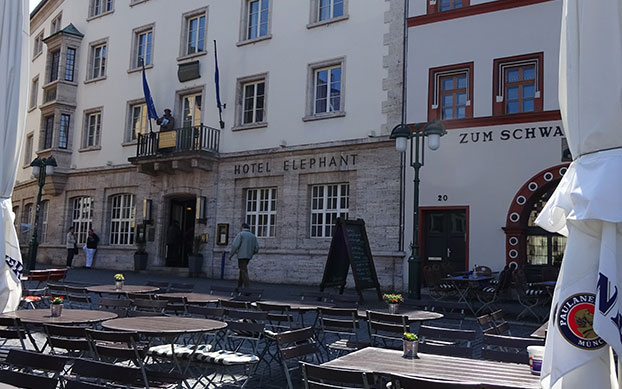 |
| Hotel Elephant // Photo by Maureen Stone |
Weimar
Weimar is Thuringia’s most artistic city, and was named Europe’s 1999 “Capital of Culture.” A local Duchess named Anna Amalia, widowed at age 17 in the mid-18th century, decided to make Weimar the “new Athens” by inviting artists, writers and composers to live and work here. The city has 20 museums and 16 UNESCO World Heritage sites. Most German school children make field trips here and more Americans (two percent of visitors) come here than anywhere else in Thuringia.
The great 18th-century German writers Johann von Goethe and Frederick Schiller both lived, worked, and have home museums here. The monumental statue of the two literary friends stands in the square in front of Weimar’s German National Theater, where their works were often performed.
Our superb tour guide, Alexander Letetzki, gave us a private tour of the home of Weimar’s resident pianist and composer Franz Liszt, who spent 16 summers here from 1869 to 1886. He was a successful, wealthy man who stayed here when not on concert tours, and Liszt is revered for teaching and financially supporting young musicians.
Weimar is the home of the Bauhaus design movement and the 1919 school where it began is a museum located opposite the Goethe House. Weimar has the largest city park, known as Goethe Park, in Thuringia and an adjacent home where the actress Marlene Dietrich briefly lived. The nearby city palace is 1,000 years old and houses the largest art museum in Thuringia.
Guests need more than a day to experience Weimar, and two hotel recommendations are worth considering. These are superior to those in Erfurt for American guests as a base for visiting both cities. At the 145-room Dorint Hotel am Goethepark in Weimar, General Manager Stefan Seiler takes attentive care of his guests with good service and comfortable amenities. Roomy guest bathrooms, an inviting restaurant and cocktail bar, and a generous breakfast buffet all make the Dorint’s double room rates, starting at 45 Euros per person, a bargain.
The 99-room Hotel Elephant has overlooked Weimar’s Market Square since 1696. A member of the Luxury Collection, the hotel has a Michelin-starred gourmet restaurant and six suites named for famous guests. Bach and Goethe, Richard Wagner, writers Leo Tolstoy and Thomas Mann and Italian composer Nicolo Paganini have all stayed here. The hotel’s most infamous guest was Adolph Hitler, who stayed here whenever speechmaking in Weimar, sometimes addressing crowds from the hotel balcony. More Weimar tourist information is found at www.weimar.de/en/.
Dornheim
The little church of St. Bartholomew is a white chapel now known as “Bach’s Wedding Church” because of the marriage here of composer Johann Sebastian Bach to Maria Barbara Bach in 1707 at age 22. This is a photo stop on your way to Arnstadt, about 10 miles away. Our visit was memorable for meeting a young couple named Katie and Stephan, who were decorating the church with flowers for their own wedding the next day, April 30, 2015.
Holzhausen
This little farm community four miles from Arnstadt is home to Germany’s only Bratwurst Sausage Museum, run by Thomas Mauer and his son Tony. This is a humorous, entertaining farmhouse museum opened in 2006 by the senior Mauer. The museum is mainly in German, and in need of translation, but visitors can follow the history of sausage making and grilling in the photos. About 50,000 guests visit this museum every year and its best features are a large, cheerful beer garden where delicious tap beers and grilled sausages are enjoyed, especially on October 3, Germany’s National Reunification Day, when “Sausage Olympic Games” are held.
 |
| Bach was an organist at this church in Arnstadt // Photo by Maureen Stone |
Arnstadt
Most of the Market Square, where Arnstadt’s tourist office is located, and the city center were rebuilt in the 1580s after a fire burned 400 houses. Dozens of members of the Bach family called Arnstadt home, and Johann Sebastian spent four years here as a young church organist and choir master from age 18 to 22. His statue, which shows Bach as a young man, was erected in the Market Square in 1985 to celebrate his 300th birthday. The house where Bach lived with his aunt is a small museum at 7 Kohlgasse near the city center.
The main attraction is the “Bach Church,” where the composer came to test a new organ and was hired to stay. He began composing here because his contract only called for 10 hours of organ work per week. This Lutheran church was very dark in Luther’s time, but renovated to a white and gold interior in 1775. A copy of an organ Bach would have played is in place above the interior of the church entry.
Another Arnstadt attraction is the baroque Castle Museum, but this requires a stair climb to reach a Bach exhibition, featuring one of his original church organs, on the upper floor. The castle was home to Prince Anton Gunther and Princess Augusta who lived here in the late 17th and early 18th centuries and its best features are a 1560 Belgian tapestry, Venetian chandeliers and the Princess’ adult collection of 400 dolls. Arnstadt is not a lively city for an overnight stay but a great lunch is found in the Winter Garden of the Brauhaus im Hotelpark, a 10-minute walk from the city center. Our excellent city guide was Andrea Seibert, available from Stadtmarketing Arnstadt ( www.stadtmarketing.arnstadt.de/en/ ).
Bad Lagensalza
This small German town has a funny name that means “Sulphur Spa” for its nearby hot springs. But there is nothing funny about the beauty and hospitality here. The city’s travertine limestone cathedral was built from 1340 to 1592 and has the second-highest tower in Thuringia, barely edged in size by Mulhausen’s cathedral. The town has a former monastery where Luther once was a guest resident, and its cloisters are the impressive setting for outdoor summer concerts from May to October. The 1739 “Graveyard Church” is a small building for V.I.P. meetings and more year-round concerts. Like other Thuringian towns half-timbered houses fill the old city center, and there are unique underground medieval storage basements in Bad Langesnsalza that attract 11,000 annual visitors on guided tours.
Most impressive in Bad Lagensalza are two recent additions. The 18th-century town hall, the city’s third such building, has a new glockenspiel (“musical clock”) in its tower with 32 bells and five marching characters that perform for about three minutes each day at 12 noon and 6 p.m. The clock was installed in 1995 thanks to the donation of a wealthy town visitor. More noteworthy are the 11 formal gardens opened in 2002 as a ring around the city walls to beautify the town after the elimination of old, unused factory buildings. The rose garden, magnolia garden and Japanese formal gardens, among several others, are alone worth a visit to Bad Langensalza, one of the highlights of our tour.
A recommended hotel stay here, which can serve as a base for visiting Arnstadt, Mulhausen, and nearby Hainich National Park, is the three-star Alpha Hotel. English-speaking owner Ursula and Charles Heinrich Scholz, natives of Hamburg, are the gracious, welcoming hosts. The attractions here are attractive rooms, an excellent lunchtime restaurant off the lobby and a rooftop garden terrace restaurant, still being completed, with commanding city views in all directions. The hotel directly overlooks part of the city parks and gardens ringing the town. More information on Bad Langesalza is at http://www.thuringia-tourism.com/travel-hotel-holiday-tour/travel-themes-127927.html .
Muhlhausen
St. Mary’s Church here is the state’s second-largest after Erfurt Cathedral, and has the highest steeple in Thuringia. It is possible to pay five euros to climb to the top via 132 steps on early Monday afternoons. Bach was the organist for two years at the town’s St. Blaise Church starting at age 22, after he left Arnstadt. There is an organ reproduced in 1958 from Bach’s written designs for the original. Groups of 25 guests can book an organ demonstration and 45-minute recital for a total group price of 65 euros.
The most famous historical event of the town is the Peasants Rebellion, which helped turn Muhlhausen from Catholic to Protestant starting in 1524. A museum in a former Franciscan church opened in 1975 and celebrates the uprising. The Muhlhausen City Hall dates from the 13th century and spans a bridge that connects the lower and upper towns. The tourist office is located at the City Hall bridge. A good place for lunch is the beer garden restaurant inside the Brauhas zum Lowen near the city center. More information on Muhlhausen is at http://www.muehlhausen.de/en/home/. Guides are a must for translations here and a recommended contact is Cindy Michael at [email protected].
 |
| Treetop canopy walk // Photo by Maureen Stone |
Hainich National Park – Thiemsburg
Thuringia’s national park opened in 1997 after being converted from a military training base. The park is 58 square miles, with most covered by farmland and forests. It is tricky to find the entrance, 16 miles on country roads from Muhlausen, and it is important that visitors head to the little village of Thiemsburg to locate the visitor center.
The main attraction here is the Treetop Canopy Walk, which is a metal-constructed walkway located at treetop level 79 feet above ground level. The trail extends for one-third of a mile and is reached by a half-mile walk from the visitor center. The greenery of the forest and the Treetop Canopy Walk are an invigorating change from the historic medieval cities of Thuringia, and park guides are available for tours in the national park. Park entry is free, but there is an admission charge of 8 euros and 50 cents and many steps to climb for the Treetop Canopy Walk.
Gotha
Our visit to Gotha coincided with the city’s annual St. Gotthard Festival, the biggest weekend of the year in honor of Gotha’s patron saint. Huge crowds turned out in the city’s main squares for music, an array of regional food stalls, children’s amusement attractions and abundant beers and wines. The highlight attraction of Gotha is Friedenstein Castle, located on the highest point in town across the street from the highly-recommended, 94-room Hotel am Schlosspark. The hillside park surrounding the castle is the largest English park outside of the UK, and the French horseshoe-style castle, started in the 13th century and completed in 1640, is the largest of its style in Germany.
Seven generations of the Dukes of Weimar lived in the castle starting from 1640. There is a portrait gallery of these ancestors in the west wing, and an audio guide in English is available. The inlaid wood floors and celebration rooms are impressive but original castle furnishings, unfortunately, disappeared with the occupying Russian troops at the end of World War II, according to our excellent city guide Birgit Moller-Carl. The guide also noted that Queen Victoria and Prince Albert of England’s house of Windsor had strong family ties to the dukes of Friedenstein Castle.
A primary attraction in the castle is the Ekhof Theater which is claimed to have the oldest working stage machinery in the world. The 160-seat jewel box theater was once the place for opera and orchestra performances for the noble families and has been remarkably preserved. It still presents an active schedule of stage and concert performances. Our memorable visit to Gotha ended with a dramatic fireworks display over the castle gardens celebrating the St. Gotthard festival with the friendly family vibe of a rousing July 4th back home .More information on Gotha is found at www.thuringia-tourism.com/travel-hotel-holiday-tour/gotha-102339.html .
Schmalkalden and the Thuringia Garden Show
This small town, whose name means “cold river” is home to 20,000 people near the Thuringian Forest and hosts the state’s 2015 garden show through October 4. The site is a string of former industrial parks that served as the tool -making capital of the former German Democratic Republic. Now, with most factories closed, the city has embraced horticulture with 10 outdoor and 12 indoor floral displays spread over 13 acres, and a green park that will remain after the show ends.
Schmalkalden, with a German federal grant, spent 30 million euros sprucing up the town since 2009 in preparation for its first Thuringian Garden Show, according to Guest Service and Group Travel Manager Janine Holz. The old city center is warm and welcoming with its large community of restored 16th to 18th century half-timber houses. Martin Luther spent time here, preaching in the 16th century and formulating his famous “Schmalkalden Articles.” These became the first written foundation for the Lutheran religion.
Here is your childhood dream of German fairy tales come true with large shopping squares and beautifully decorated homes, some original and some recreated. There was a festive weekend atmosphere enlivened by 3,000 students who attend the local applied science university. Our biggest regret in Thuringia was not having more time to linger and explore Schmalkalen. Contact Janine Holz for English-speaking guidance: [email protected] and find more information at http://www.thuringia-tourism.com/travel-hotel-holiday-tour/144124.html .
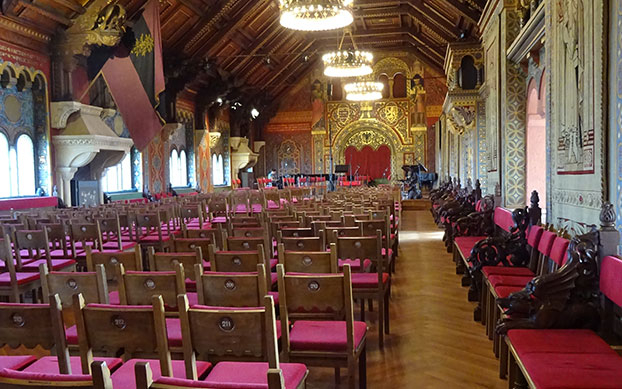 |
| Great Hall in Wartburg Castle // Photo by Maureen Stone |
Eisenach and Wartburg Castle
This was the last but by no means least stop on our visit to Thuringia. While Eisenach, apart from the spectacular UNESCO World Heritage Wartburg Castle, is not the prettiest town in Thuringia, no city in the state exceeds it for historic content. Johann Sebastian Bach was born and baptized here at St. George’s Church in 1685, and Martin Luther went to school here as a young student. Luther’s home, now being restored, will open as a museum this September, and the Bach House Museum is the world’s oldest and largest dedicated to the composer with many original signed works.
The star of Eisenach is indisputably Wartburg Castle, which sits atop a 1,300-foot mountain overlooking the city. First constructed in the 12th century from limestone hauled from 25 miles away, the castle was the home of St. Elisabeth of Hungary, a young royal widow inspired by St. Francis to help the poor and open hospitals and schools before being canonized as a saint soon after her death at age 24 in 1231. Martin Luther was hidden away in Wartburg castle in 1521 and began his translation of the New Testament, the first in the modern German language, and his castle cell can be visited.
The castle is famous for the historic demonstration by 500 university students, who met here in 1817 to demand more democratic rights from the German dukes. “Since 1990 [reunification] we have finally had the rights that those students first demonstrated for,” said Philip, a Wartburg Castle guide who is himself a student in Eisenach. The castle has a daily tour in English at 1:30 p.m. The final highlight of our visit to Thuringia was a concert in the Great Hall of Wartburg, the largest medieval public hall in central Europe, by the Stuttgart Chamber Orchestra. The group played works by Franz Liszt, Nicolo Paganini and several 20th-century composers.
Guests who want the full experience of Eisenach should consider the 37-room Romantik Hotel, located on the mountain just below Wartburg. The 100-year-old property has a gourmet restaurant, atmospheric wood-beamed public rooms and panoramic views of the Thuringian Forest and countryside surrounding Eisenach. Another hotel choice near Eisenach’s city center is the Steigenberger Hotel Thuringer Hof, with its excellent Leander wine bar located on the Karlspatz square. Find more information on Eisenach at http://www.eisenach.info/en/.
What do you think of this $type?

